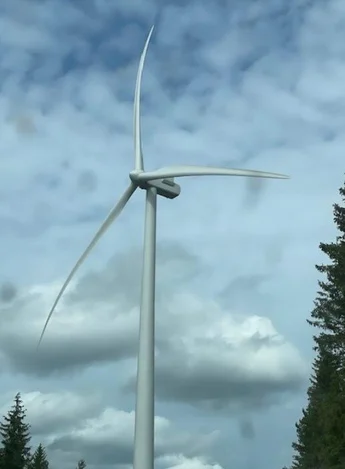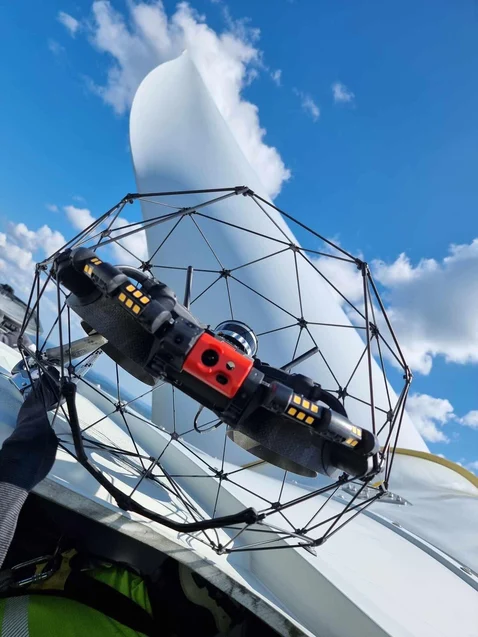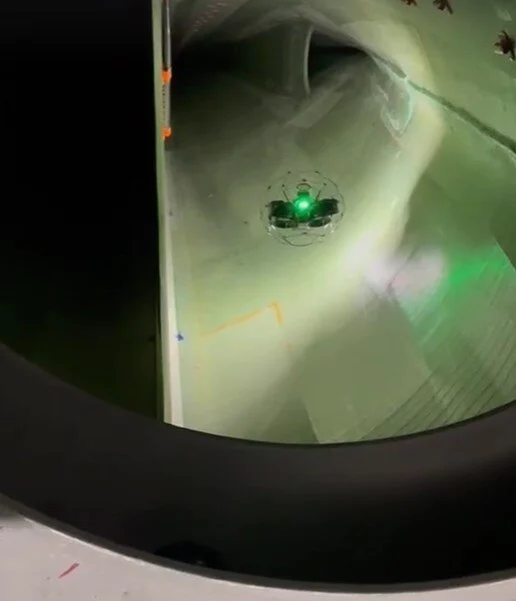Wind Turbine Blade Inspections with the Elios 3
Explore how the Elios 3 revolutionized wind turbine blade inspections, delivering results in just one day instead of five!
Key Benefits at a Glance
|
Safety Inspecting the inside of a wind turbine blade involves working at height and in tight spaces. The Elios 3 eliminates the need for human entry, significantly reducing risk and ensuring safer operations. |
Speed The Elios 3 completed an entire blade inspection in just 27 minutes, while traditional methods would take over two hours with a rover or up to two days with manual inspections. It's clear that drone technology is the fastest option available. |
|
Data Quality Equipped with a 4K camera and LiDAR, the Elios 3 captured high-resolution images and detailed point cloud data, allowing inspectors to identify lightning damage and past maintenance work along the full length of the blades. |
Access Thanks to its compact design, the Elios 3 can easily enter each blade from the hub, reaching nearly the entire length without needing to reposition. This makes it ideal for capturing critical internal data remotely. |
According to the Global Wind Energy Council, there are more than 341,000 wind turbines installed worldwide. These massive structures are highly efficient, with an average turbine from 2020 generating enough energy to power a household for a month in just 46 minutes. However, maintaining these systems presents unique challenges.
Wind turbines are located at great heights and often in confined spaces. Accessing them requires specialized training, such as that provided by the Global Wind Organization, which ensures workers can safely move in and out of the structure and handle emergencies. Due to these challenges, finding qualified personnel for inspections can be difficult and costly.
Why Use Drones for Wind Turbine Inspections?
In February 2024, Drone Solution, a Swedish service provider, partnered with a wind turbine management company to test whether drones could inspect the interior of wind turbines. While they already used drones for external inspections, this was the first time they attempted internal blade inspections using a drone.
 The sheer size of wind turbines makes them difficult to inspect
The sheer size of wind turbines makes them difficult to inspect
Inspections typically focus on identifying manufacturing faults or damage from lightning strikes. A lightning strike may leave only a small mark on the exterior, but the interior could have significant damage that risks the entire turbine. In some cases, if the Lightning Protection System is not properly configured, the blade could even explode due to internal pressure. Regular inspections are crucial to prevent such issues, especially since repairing a damaged blade can cost up to $1 million.
Drone Solution wanted to demonstrate how the Elios 3 could make internal inspections faster, safer, and more efficient. Their goal was to show that both internal and external parts of a turbine could be inspected using drones, offering a better alternative to traditional methods.
Planning the Inspection with the Elios 3
Each wind turbine has three blades, and each must be individually inspected. Traditionally, this process requires trained personnel to crawl through the narrow, tapered space, often split by shear webs. Each blade must be rotated to inspect both sides, making the process slow and labor-intensive. With the Elios 3, however, the entire inspection can be done in a fraction of the time.
As a result, traditional blade inspections can take anywhere from 5 to 9 days depending on the turbine size. Drone Solution wanted to see how much faster the Elios 3 could make the process.
The Process: Drone Wind Turbine Blade Inspection
The demonstration involved a turbine with 67-meter-long blades. Before starting, the inspectors had completed their wind turbine training. At the site, they took a 20-minute elevator ride to the hub, where access hatches for each blade were located. They programmed the turbine to pitch two blades upward, at positions matching 10 and 2 on a clock, to ensure safe operation in case of any issues during flight.

The Elios 3 outside of an access hatch on a turbine
The Elios 3 was flown into each blade and along the shear webs, covering 30 meters of the structure. Using the 4K camera, the pilot captured visual data and identified potential issues, including suspected lightning damage. The LiDAR scan helped navigate the space when the drone was out of sight, and also provided distance information to track progress.
The entire inspection of one blade was completed in just 27 minutes, with three flights required to cover all areas. The process was repeated for each blade, and then the team used a separate drone to inspect the turbine’s exterior.

Snapshot: the Elios 3 flying inside a turbine blade with the shear web on the left
Results of the Drone Wind Turbine Blade Inspection
Both Drone Solution and their client were amazed by the results. The Elios 3 revealed internal damage that wasn’t visible from the outside, proving the value of drone inspections compared to traditional methods.
Traditionally, such an inspection would require two trained individuals in the hub. With the Elios 3, only one person was needed, reducing risk and effort. Each blade was inspected in under 30 minutes, far quicker than the 2+ hours required for a rover or a full day for manual inspection.
Thanks to the success of this trial, Drone Solution hopes to expand drone inspections across more turbines and wind farms. This innovative approach offers a safer, faster, and more reliable way to maintain wind energy infrastructure, opening up new opportunities for the future of wind turbine maintenance.
Ningbo Senmiao Trading Co., Ltd. , https://www.nbsenmiao.com